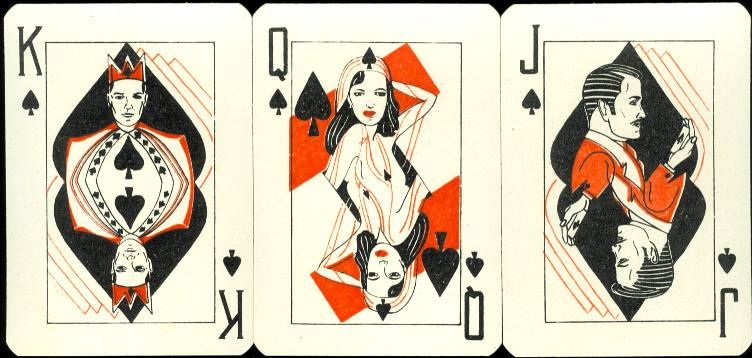
December 2010
There was some discussion here regarding this month's choice. The discussion had nothing to do with the number of decks to choose from, we've had worse months. The usual monthly flea market in Utrecht brought us some new decks, just like the Dutch collectors meeting in Velddriel. Most of the decks that we bought on Ebay this month are probably delayed by the bad weather and the extra effort that the holiday season brings for the mailmen and women all over the world. But we did receive some gems for our collection from Ebay sellers.
There were two decks that we had bought there just to improve the quality in our collection and these caused a lively discussion here. Since we've started this xpo we've only shown decks here that were at that moment new in our collection. But now we had received a wonderful and rare deck, that wasn't new in our collection, but that was in unused condition, while the deck in our collection had been used and has some light general soiling. It took a little discussion, but re-reading the text in the intro of this xpo paved the way for this deck. It doesn't really say that the chosen deck had to be new for the collection, just that it has to be the best acquisition this month. And on that we both agreed.
So we're glad to present you the rarely seen Vannini Pocker deck........


We first saw the deck in the famous book about Art Deco playing cards by Uwe Volker Segeth. It took us a while and a good amount of money to buy the (first) deck several years later. The Art Deco influences are best seen on the Queens and the back design. In his description Mr. Segeth mentions that the deck was a special edition for the 5th US Army, made in 1945 by Vannini from Florence (Firenze). But this needs some specification. In the back design there's a red bull skull, which can also be found on one of the jokers. This skull refers to the 34th "Red Bull" Infantry Division, which was only one of the Divisions of the 5th US Army.


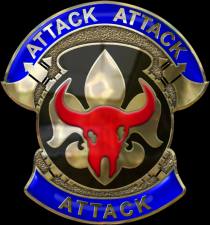 |
The 34th Infantry Division is a division in the Army National Guard that participated in WW I, WW II and continues to serve today. In WW II the division got its training in Ireland and first engaged in battle in Northern Africa in November 1942. From there they were employed in the landing of Salerno, Italy, in September 1943. On January 24th 1944 they fought a heroic battle at Monte Cassino. While they nearly captured the objective, in the end their attacks on the monastery and the town failed. The performance of 34 Division in the mountains is considered to rank as one of the finest feats of arms carried out by any soldiers during the war. They were relieved from their positions 11–13 February 1944. Eventually, it took the combined force of five allied infantry divisions to finish what the 34th nearly accomplished on its own. After rest and rehabilitation the divison landed at Anzio beachhead, 25 March 1944. |
 |
|
Official Unit Insignia |
(SSI) Shoulder Sleeve Insignia |
|
|
The Division participated in six major Army campaigns in North Africa and Italy. The Division is credited with amassing 517 days of front line combat, more than any other U.S. division. But there was a toll. The 34th Division suffered 3,737 killed in action, 14,165 wounded in action, and 3,460 missing in action, for a total of 21,362 battle casualties. The division's soldiers were awarded 10 Medals of Honor, 98 Distinguished Service Crosses, one Distinguished Service Medal, 1,153 Silver Stars, 116 Legion of Merit medals, one Distinguished Flying Cross, 2,545 Bronze Stars, 54 Soldier Medals, 34 Air Medals, with duplicate awards of 52 oak leaf clusters, and 15,000 Purple Hearts. ...with thanks to Wikipedia. |
||
The liberation of Florence came on August 4, 1944. But the war in the whole of Italy officially ended on May 2, 1945, when the last German troops surrendered and the Division had reached the French border. The 34th Division wasn't inactivated until November 3, 1945. So the deck has to have been made somewhere between those dates, most likely between May and November 1945.
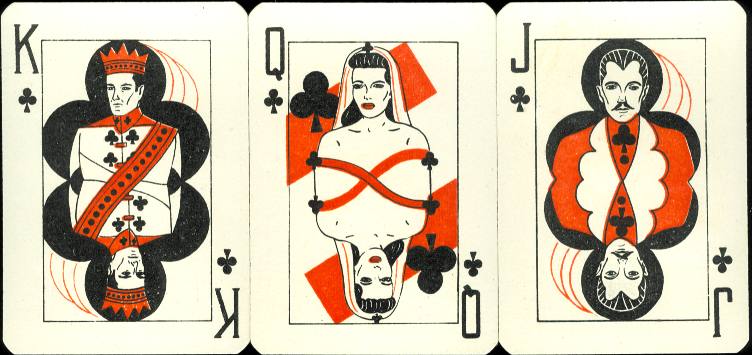

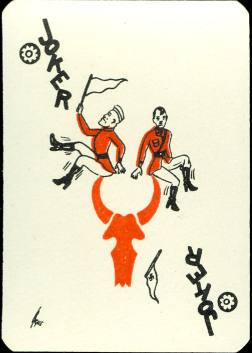 |
Both jokers express their connection with the 34th Division. On the first one their red bull skull has Mussolini and Hitler on its horns and the second one shows the outline of the SSI with a cute girl stepping out of it. Maybe they represent the (end of) fighting and the R&R? |
|
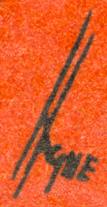 |
The box mentions the title and maker of the deck. It also shows a circular company logo, with the letters FCGV (Fabrica di Carte da Giuoco Vannini). But it's harder to find out who had made the designs for the back, courts and jokers. The back design and the joker both show a signature, but even when enlarged it's hard to read the name. |
|
|
On the back design the first letter seems to be an H, followed closely by a triangular looking A. The next letters could be read as a Y, an N and an E, but as the enlarged signature of the joker shows, the Y looks more like a G and the N looks more like a U there. So the signature could be spelled Hague, which name isn't typical Italian and could mean that the deck was designed by one of the enlisted men of the 34th. Maybe during their R & R? |
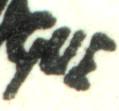 |
|
|
In 2016 we received an interesting observation by our fellow-collector Gustavo Orlando-Zon, who had found a similar signature by the American artist Alexander Hague (1898 - 1994). Gustavo also wrote "This artist, during WWII devoted himself to defense work at North American Aviation in Dallas, and realized many war pictures and drawings. His signature is really similar to the signature of Military Pocker, and his selfportrait seems the same of the jacks faces of the deck." He had attached a few examples of Hague's art and signature. Of course we did some research ourselves and we would agree. So a BIG thanks to Gustavo! |
||
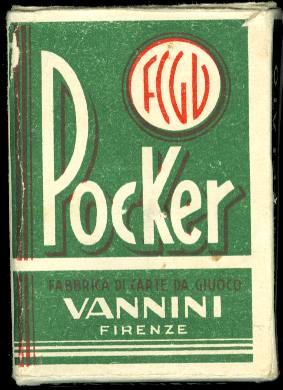
|
|
|
On
October 1st 2011 we received the above images from Richard King, who had
bought a similar Vannini Pocker deck from an antique dealer in the
US. |